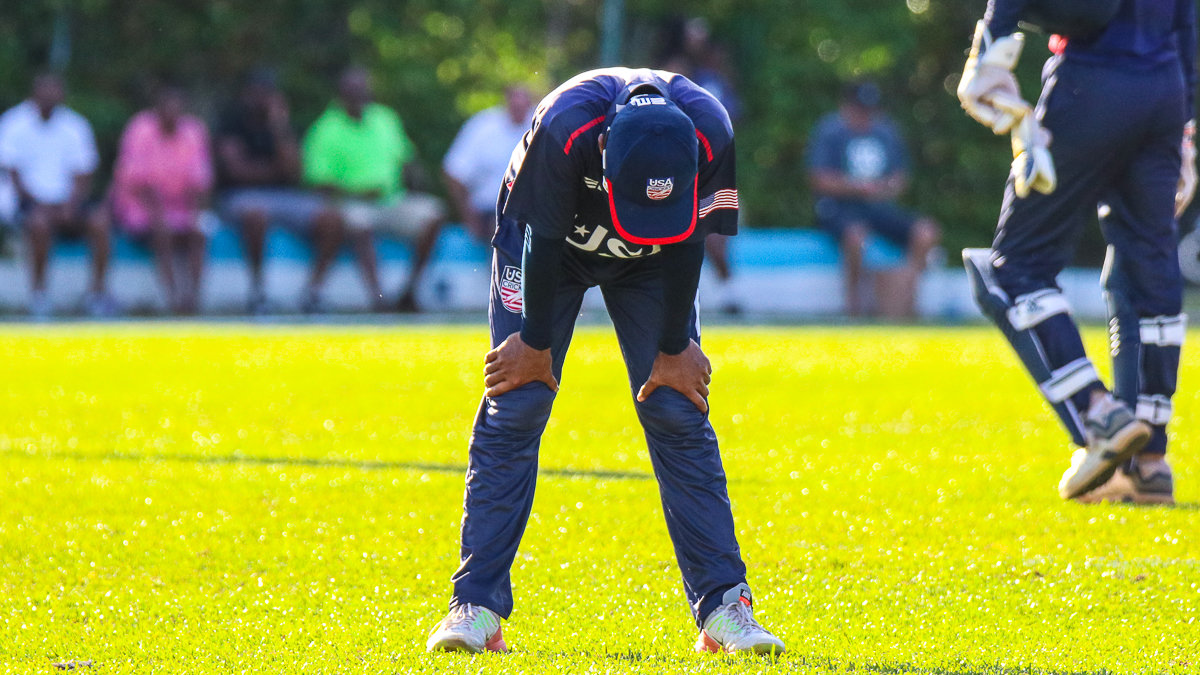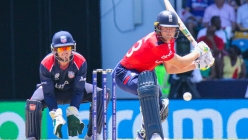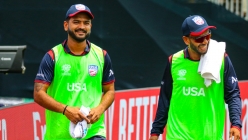USA Cricket: 2019 ICC T20 WCQ Americas Regional Final Report Card Part 1 – Team Grades
2019 Aug 27 by DreamCricket USA

Photo credit: Peter Della Penna
In part one of DreamCricket's tour report card breakdown of the disappointing tour of Bermuda for 2019 T20 World Cup Qualifying, five collective group aspects of USA's squad performance have been graded.
By Peter Della Penna (Twitter @PeterDellaPenna)
Batting: F
USA’s worst tournament performance in their T20 history, and arguably their worst in any limited overs tournament ever since they traveled to England for the ICC Trophy in 1979, was mainly a result of the continued batting failures. It started at the top with generally poor platforms laid by the top order during the Powerplay.
USA’s average score after the first six overs was 41 for 2. The tone was set on the first day against Bermuda when USA had 24 dot balls (out of a possible 36) and no sixes in the Powerplay chasing a target of 142 against Bermuda, typifying their overall lack of intent. They struggled at the death as well with 11 dot balls in the last five overs in that same match that ended in a six-run defeat.
On an admittedly difficult wicket the next day against Cayman Islands, USA had another 22 dot balls in the Powerplay, but the hidden picture in there was that even the loose balls USA couldn’t figure out how to put away unlike Canada who belted three fours and three sixes in the first four overs of their chase against Bermuda on the same treacherous wicket before rain stopped play. There were another 15 dot balls in the Powerplay on day three vs. Canada, 16 more against Bermuda on day four, 23 more against Cayman Islands on day five before just 10 dot balls on the final Powerplay against Canada in which they reached their best of 62 for 3. Combined, it means USA had a total of 110 dot balls in the Powerplay on the week.
By comparison, Canada had 107 balls in the Powerplay. But the difference is that Canada were far more aggressive when loose balls presented themselves. Over the first four days of the tournament before USA was eliminated, they scored just 12 fours and three sixes in the Powerplay. By comparison, Canada had 13 fours and nine sixes while Bermuda had 16 fours and five sixes over the first four match days. The only time USA defeated Bermuda or Canada in boundary efficiency in the Powerplay was on the last day against Canada when USA scored three fours and five sixes to reach 62 for 3 in six overs, but then proceeded to add just 98 runs in the final 15 overs.
USA had 27 sixes on the week, but only 15 through the first four games when they were eliminated. Bermuda struck 12 alone on match day four when they eliminated USA and secured their own berth to the T20 World Cup Qualifier in the UAE. Bermuda struck 35 on the week while Canada hit 54 sixes, twice as many as USA, highlighting the gulf between the two batting units. In terms of just fours, Canada struck 46, Bermuda 50, and USA 39. All totaled, Canada scored 508 runs from boundaries in just 84.3 overs (1.18 boundaries per over), Bermuda struck 410 boundary runs from 90.4 overs (0.94 boundaries per over), while USA had just 318 boundary runs from 104.4 overs (0.63 boundaries per over). Essentially, Bermuda was 1.5 times as likely to hit a boundary as USA while Canada was twice as likely to hit a boundary as USA for every delivery at the crease.
USA only had one player – Steven Taylor, cross 100 runs on the week, while Bermuda had two (Delray Rawlins and Kamau Leverock) while Canada had three (Ravinderpal Singh, Navneet Dhaliwal and Rizwan Cheema). Similarly, they couldn’t string together partnerships. USA had just one 50-plus stand – in the nine-wicket win over Cayman Islands, and that too came after Monank Patel was dropped on 0 while Taylor was dropped later in the stand on 40 with the stand at 48 – while Bermuda had two and Canada four. Pretty much any place to look, whether individually or collectively, USA failed on the batting front.
Bowling: D
The pace bowling unit in particular was a failure, both in the Powerplay and at the death. After Jessy Singh’s double-wicket maiden in the second over of the tournament against Bermuda, things went pretty much downhill in the pace department.
Canada’s Dillon Heyliger and Romesh Eranga combined for 20 wickets on the week with Heyliger named the tournament’s best bowler. Onias Bascome of Bermuda also was able to trouble batsmen off a short runup with his gentle medium pace, taking eight wickets. The group of Saurabh Netravalkar, Cameron Gannon, Jessy Singh and Timroy Allen collectively took 10 wickets in 37.1 overs. It highlighted how badly they missed Ali Khan. The spinners picked up the slack, in particular Karima Gore and Timil Patel, and as a group they took 31 wickets.
In the extras department, USA did wonders to help the other team out with free hits, that too at the most inopportune times. USA bowled seven no balls on the week, including four by Jessy Singh – three of which came in a 21-run over – in the opening day loss to Bermuda. USA also failed to bowl in partnerships, something they did incredibly well at WCL Division Two in Namibia. The good work done at one end, by someone like Gore, was often quickly undone by the person operating at the opposite end.
USA also struggled badly to contain pressure on the final ball of an over. USA conceded boundaries on the final ball of an over five times in the first matchup v Bermuda and then five more times in the rematch. Bermuda’s bowlers on the other hand conceded no boundaries off the final ball of an over in the first match and just once in the rematch with USA. Those moments were deflating for USA in the field as bowlers failed to see out an over. On the whole, USA conceded a boundary off the final ball of an over on 19 occasions in Bermuda. Canada’s bowlers did it just 10 times while Bermuda let it happen just four times. Bermuda’s bowling discipline in key moments vs. USA’s indiscipline was a major factor in USA losing both matches to the tournament hosts.
Fielding: B-
On the week, USA missed eight clear chances (six drops, two missed runouts), that cost them a total of 60 runs after the first missed chance. They highlighted some narrow margins too. Netravalkar dropped Onias Bascome at short third man off the bowling of Hayden Walsh Jr. in the 16th over of the first innings of the first match against Bermuda. It cost four runs in a match decided by six runs.
Xavier Marshall had two drops on the week, but one came in the second match against Bermuda with Allan Douglas on 1. Though it only cost two runs, the casual nature with which Marshall approached the chance in the 16th over with his arms tucked completely into his body, gave insight into the mental state of Marshall and the team in that they did not look like they were fighting with a sense of urgency, specifically that their tournament lives were on the line. The costliest drop came in the second Canada match when Nisarg Patel spilled Navneet Dhaliwal on 1 off the bowling of Karima Gore. Dhaliwal went on to make 36 in Canada’s 15-run win.
Conversely, USA’s opponents gave USA batsmen eight chances that contributed a total of 67 runs after the first missed chance. The biggest recipient of good fortune from the opponents was Taylor. He should have been runout on 1 against Bermuda in the rematch but George O’Brien botched a relay from Onias Bascome at short third man and Taylor went on to make 23. Taylor was also dropped on 40 by Alessandro Morris at extra cover in the second match against Cayman Islands and finished 56 not out.
On the whole, USA’s net gain was +7 runs from missed chances by the opposition during the week. But in matches against Canada and Bermuda, it was minus-10. USA’s ground fielding was generally sharp, spearheaded by Walsh Jr., Taylor, Gore, Allen and Aaron Jones. In general USA’s failures at past tournaments have been down to fielding and fitness, but neither could really be seriously blamed for USA’s overall results on this tour.
Fitness: B+
Picking up from the previous section, this is the one area where USA has struggled greatly over the years but with players now on full-time contract commitments, they showed noticeably improved endurance and stamina in the field. Credit goes to Burt Cockley for the strength and conditioning program he has designed that has made USA’s players much more fit than in years past, especially taking into consideration how hot and humid most days at the tournament were in Bermuda.
Team Selection: F
This goes for before the squad was assembled and on a game-by-game basis during the tour itself. As was the case made by this reporter last September in North Carolina, if Timil Patel isn’t in the starting XI and bowling a full four overs then don’t bring him on tour. Timil is not a bench player. He’s the career-leading wicket-taker for USA in both 50-over and T20 cricket. This seemed to be lost on the new management regime and proved costly in the opening day loss to Bermuda when he was left out of the XI. He proceeded to take eight wickets over the next three games, including 4 for 27 against Canada. Karima Gore also showed over the final four days that leaving him out of the first two games was a folly. Nisarg Patel fared well with the ball when given a chance but only bowling him for one over on the first day against Bermuda seemed a miscalculation, especially with Timil and Gore left out.
Xavier Marshall had demonstrated over the first three days that he was out of form and not in position to continue persisting with in the XI. Monank Patel hadn’t done much better, but rather than dropping either of them heading into the do-or-die day four encounter against Bermuda, team management dumped Jaskaran Malhotra. To recap, Malhotra top-scored for USA on day one against Bermuda with 38 off 39 balls, his scoring rate hamstrung by poor support around him from Marshall and Monank. Malhotra was then sold out by a ball-watching Marshall against Cayman Islands for 3. Then in the third match against Canada, he was one of the few who actually attempted to up the ante after being bumped down to the middle-order so Monank could open, eventually falling to a slog sweep caught at deep midwicket for 4. Yet, despite far more egregious failures from Marshall and Monank, it was Malhotra who made way in the must-win elimination match against Bermuda. Keeping Marshall in the XI was exposed both at bat and in the field when he played a poor shot driving to one of the only two men out of the ring in the Powerplay before committing a sloppy drop at long-off in the closing stages of the chase.
As for selection errors before the tour began, leaving Elmore Hutchinson out was a mistake. When the chips are down, the 37-year-old Hutchinson has been someone who has bailed USA out from countless situations with lower-order hitting in particular while his nagging bowling length would have been a handful on the wickets used in the tournament. Hutchinson’s experience is undervalued and he has been the most underappreciated player for USA over the last decade. As someone with a nice-guy reputation, he may have been a soft target to be bumped out of the squad in order to make room for either of Cameron Gannon or Jessy Singh.
According to sources, Singh had initially only been offered a three-month deal with USA Cricket but used his draft selection for Toronto Nationals at the Global T20 Canada as negotiating leverage to secure a one-year contract offer from USA Cricket in order to get him to withdraw from the GT20. Selecting Singh for the tour of Bermuda appeared to be done mainly as a means to justify having given him a one-year contract rather than picking the best 14 players. Hutchinson has consistently outperformed Singh at just about every turn in recent years with both bat and ball and his vast experience was sorely missed in key moments.
Gannon was picked in the 14 on account of having demonstrated good skills bowling at the death during the team's three-week training camp in Los Angeles - that too after having been flown in on a strong recommendation from new bowling consultant coach David Saker - but those death bowling skills were absent when he bowled a fateful 19th over against Canada on day three of the tournament as he conceded a last-ball six to Dillon Heyliger to end a 14-run over that put Canada one shot away from victory. Dropping him for the last two games was a reminder that just because a guy has first-class cricket on his resume doesn’t guarantee he’ll walk right in to the starting XI and be a superstar for USA. By contrast, the value of former Jamaica Tallawahs squad member Hutchinson rose through his absence from the touring squad.
Bringing Sunny Sohal in as a batting reserve when Ali Khan had to withdraw from injury also backfired. According to sources, Akshay Homraj and Sagar Patel were the two players who had been tabbed as first-choice reserve batsmen in case of injury coming out of USA’s three-week camp in Los Angeles. But Sohal leapfrogged them on account of his decent run of scores at the GT20. The problem with that is the GT20 was played on flat drop-in pitches with embarrassingly short boundaries. Sohal has rarely performed for USA in the past and his experience in Bermuda was not much different. In every USA national team camp Homraj has been a part of, he has demonstrated consistently fearless, attacking instincts. Sohal on the other hand came out looking like a deer in the headlights in a must-win match against Bermuda, out lbw for 5 off 11 balls.
In terms of other fearless batsmen, Fahad Babar’s technique is something that has never won selectors over, but he was the Best Batsman and Tournament MVP of the previous T20 Americas Final in Indianapolis in 2015 (yes, he outscored Steven Taylor). In part it was because of his fearless approach in the Powerplay but also because he has a sharp temperament and doesn’t get flustered if a few dot balls accumulate. That approach was absent in Bermuda and it’s a serious misjudgment by team management and selectors that he has fallen so far out of favor. He played one of the best knocks of the June 2018 USA national team trials in Houston with an unbeaten 70 on the final day but was ignored for other options and hasn’t been heard from since. He was left out of the broader squad camp held in Los Angeles in June, while other random players outside of the announced invitees were regularly funneled into intrasquad trial matches throughout the recent three-week camp in Los Angeles. The bottom line is that too much emphasis has been put on technique in recent years and next to no consideration has been given to temperament, especially in T20 cricket, much to the detriment of a player such as Babar.
Nicholas Standford was also twice Man of the Match against Hong Kong and Papua New Guinea in the 2015 T20 World Cup Qualifier in Ireland with knocks of 40* off 25 balls and 40* off 17 balls, precisely the kind of acceleration USA missed in the middle order. But based almost purely on his 50-over form, he has been discarded from USA’s T20 cricket plans as well.
This result, as well as USA’s two matches against Canada in North Carolina last September, has highlighted the fact that USA needs to get serious about making a hardline distinction between picking players for 50-over cricket vs. players much better suited to T20 cricket. Considering the volume of T20 cricket that is played domestically vs. the complete absence of 50-over league cricket around the USA barring a handful of leagues, it should theoretically have been easier to scout out the best 14-man squad for USA in T20 cricket. But this last week has shown that there are still faults in the talent identification pathway.
[Views expressed in this article are those of the author, who was present at all of the team's matches on tour in Bermuda, and do not necessarily represent the views of DreamCricket management. If you have different views or opinions, we respect those views and urge you to provide your feedback, both positive and negative. Feel free to respond to the author via Twitter @PeterDellaPenna.]




